As always, if you haven’t already, head over and join our discord to hear about new Dev Diaries as soon as they go up!

The Heart of To The Rescue!
It’s been a while since the last Dev Diary! We’ve been doing a lot of behind-the-scenes work that isn’t very exciting to read about, but I thought we would jump back in with a new feature that is SUPER important to TTR. Adoptions.
Adoptions are what the game is about at it’s core. Every dog deserves a loving home and your role in getting them there in To The Rescue! should feel almost as good as it would in real life. There will inevitably be some sad or stressful situations in the game, but our goal is to make sure that each successful adoption is an emotional bookend to those less positive moments.
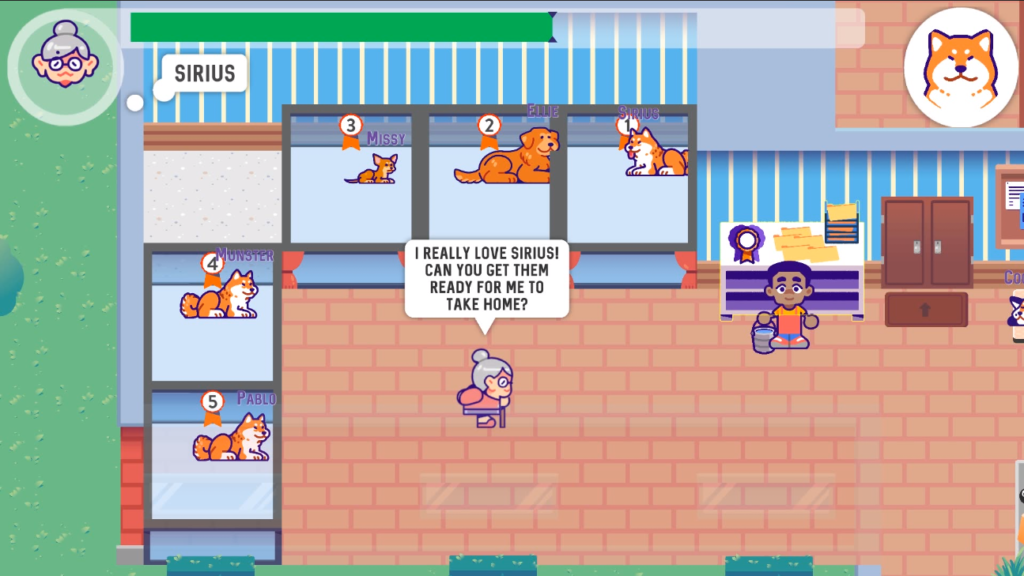
There is a lot to unpack with this mechanic though. How do we simulate an adoption? How does the player maintain an active role during this process? Can we make the emotional core of the game, just as rewarding and engaging as the rest of the mechanics?
Adoptability?
One of the hardest tasks is finding a way to weight how appealing a dog is to a given visitor. Every dog is 5 stars to the right person, but some dogs do need special accommodations. To address this, we decided to determine their appeal or “Adoptability” in several stages.
First, each trait has a base impact on their adoptability. This is a measure of how the trait would mesh with the “average” adopter. For instance, a dog with the tendency to bite or snip would generally appeal to fewer potential adopters than being good with kids. That doesn’t mean that the former dog can’t find a good home, just that they need someone who can accommodate and mitigate their negative behaviors.
All of their traits are summed together with the base adoptability (3 Stars) to create a composite score. But as those “glowup” rescue dog posts we see on social media show us, a bath, a checkup, and a healthy diet can go a long way towards a dog’s adoptability. That’s why we use the aforementioned composite score as their ‘maximum adoptability’. Their welfare determines how their current adoptability stacks up with their maximum adoptability. A dog getting a low rating from a visitor, might just need a bath and nice meal!
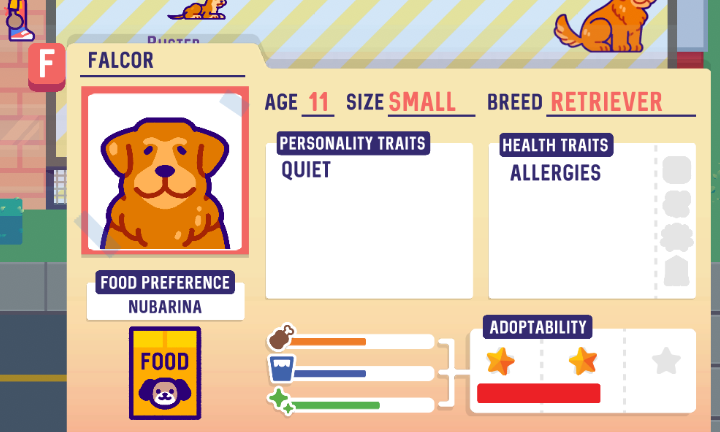
On top of their welfare, they can gain and lose traits from shelter conditions or special events. But honestly? The adoptability in their file is just an estimate. What really matters is the connection between a potential adopter and the dog.
Playing Matchmaker

The visitors to the shelter are just as varied and unique as the dogs you take care of and each one of them could be looking for something different in a dog. These individual preferences are the next layer to a dog’s adoptability.
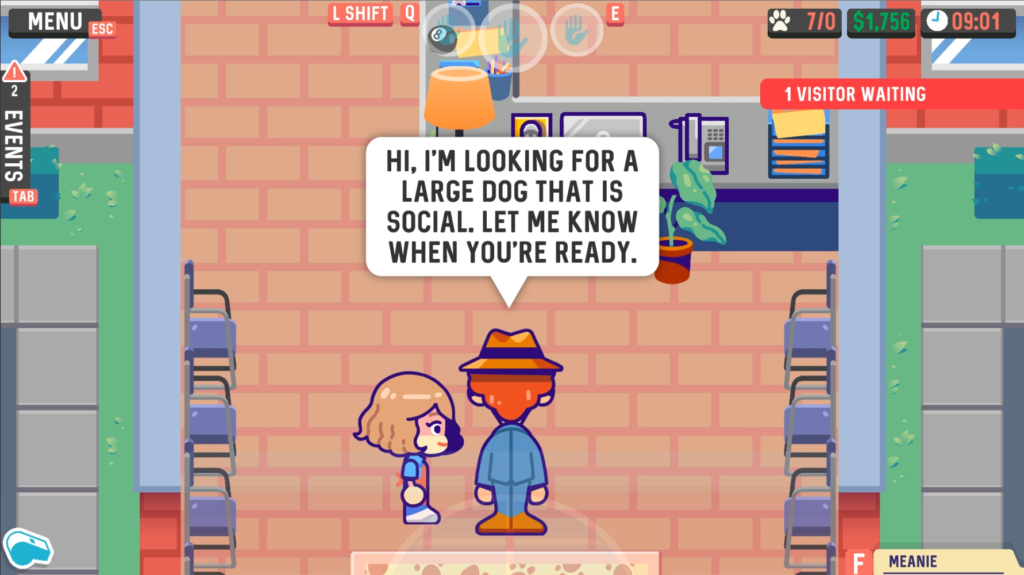
Each visitor that arrives shows up with a general disposition and maybe even a clear idea of the kind of dog they are looking for. They might want a dog of a certain breed, size, with certain traits, without certain traits, or traits they don’t mind. Dogs that they view that match this criteria get a bonus towards their adoptability in the visitors eyes.
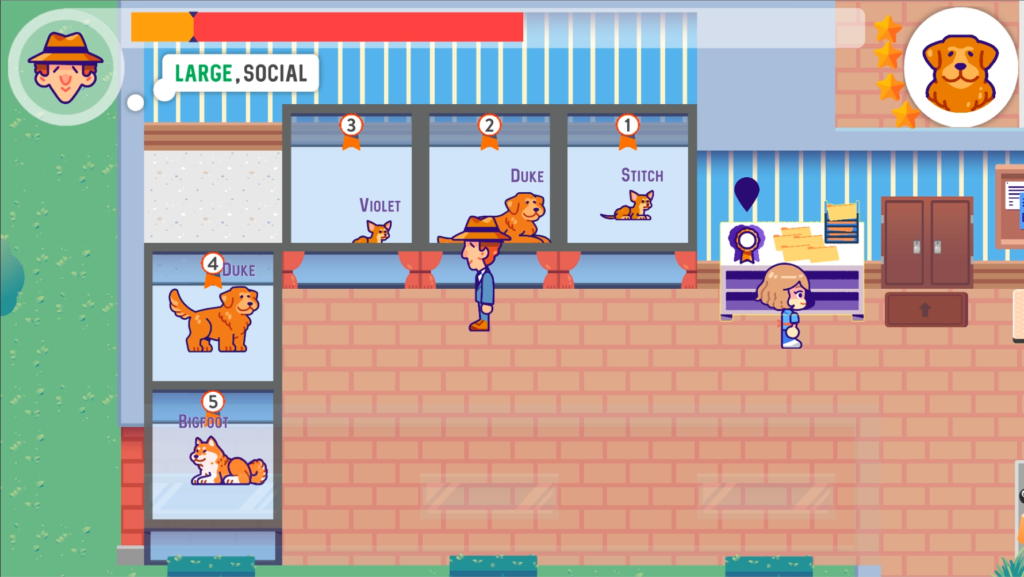
But just because they see a dog that matches what they were looking for when they came in, doesn’t mean that’s the one they will be leaving with. Sometimes you just know the right dog when you see them, even if you weren’t looking for them!
So how do you give a dog the best possible chance to find a home? Well, you’ve got a lot of options. Make sure they have a high welfare level by filling their needs, give them some extra attention to score a happiness bonus, and match them up with a visitor’s preferences! But what if that still isn’t enough?
How it Works
That’s where our new mechanic comes in. During adoption, the player will have some opportunities to intervene, hopefully fudging things for a better outcome. Let’s work through an adoption, step by step.
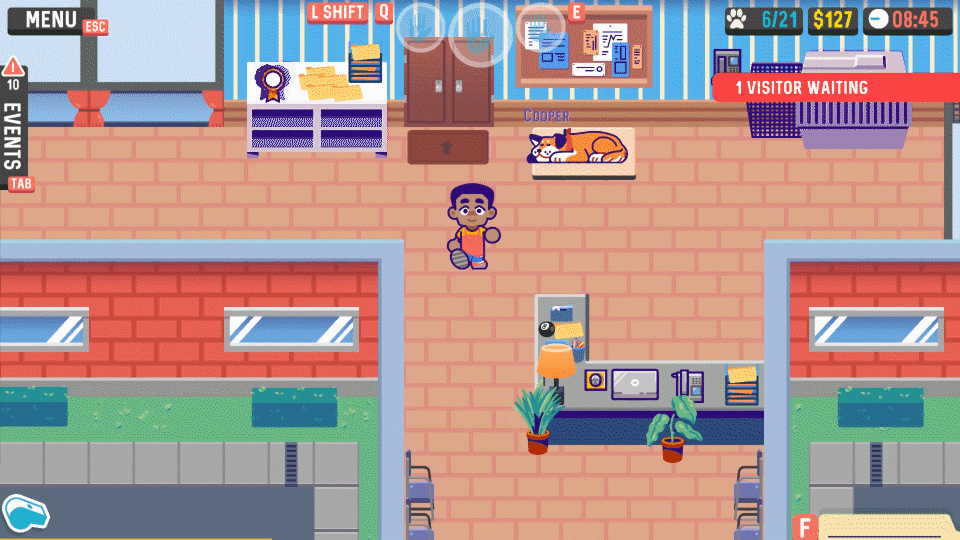
When a visitor arrives, the player will get a notification, so the first step is to go and greet them to find out what they are looking for. Any preferences they have will be stored on the task panel. This visitor is looking for a dog that is Trained and Intelligent. High standards!

So, next the player needs to check if they have any dogs that match the visitor’s preferences. A real pro will have a good idea of the dogs in their shelter but if the player isn’t sure, the folder has all the information that might be relevant to an adoption. Sirius here is a perfect match. But their welfare could use some work. It’s knocking their adoptability down to three stars from their five star potential.

This is an easy fix though. Let’s grab Sirius’ favorite food and some fresh water! That will definitely give them a boost. This is a pretty simple solution, but sometimes a dog might be sick, injured, dirty, and needs a bit more work to get ready.
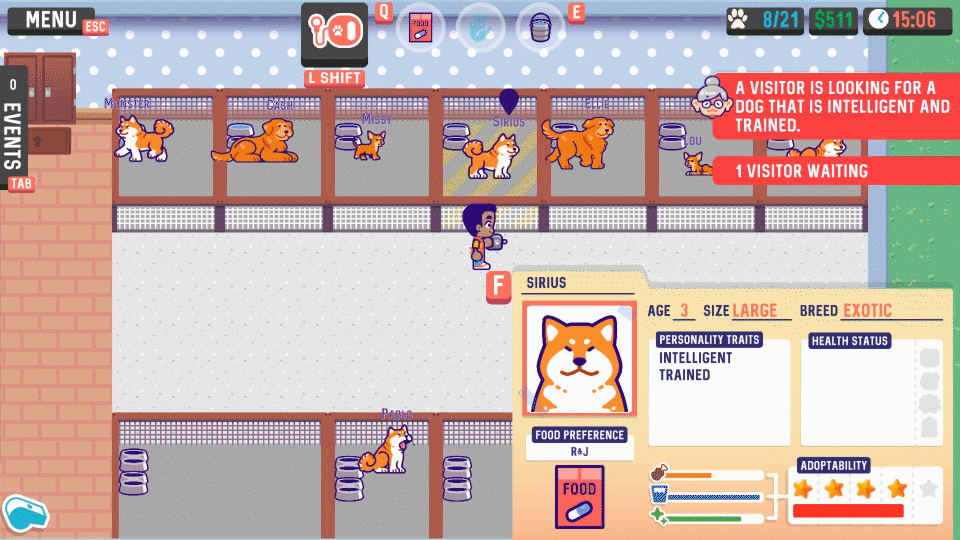
Alright, as Sirius digs in, we can see their welfare raise enough to reach their maximum adoptability. Just bumping them from 3 stars to 5 stars means that their chance for being picked just increased by 66%

Now that Sirius is all taken care of, let’s grab the Show Ribbons to move Sirius and some other dogs out to the show kennels. The Show Ribbons let the player quickly move dogs to the Show Kennels while keeping them linked to their home kennels.

Let’s see what the visitor thinks of Sirius. Five stars… plus two bonus stars for their trait matches for a total rating of SEVEN STARS! That’s good because to trigger an adoption, the visitor’s willingness (yellow bar) needs to exceed their resistance (red bar). If the player can’t beat that, they might leave without adopting any of the dogs.

After seeing all five dogs, the visitor just isn’t sure. This is when the player can intervene. They have a few options to nudge things along. They can give a discount to boost each dog’s rating by 20% but lose money on the adoption fee, emphasize a trait match to give a particular dog a better chance, or let the visitor spend some one-on-one time with the dogs to boost each dog’s rating at the expense of time.
When their willingness finally exceeds their resistance, they are ready to choose! Each dog’s chance to be picked is proportional to their impact on the visitor’s willingness. Here we picked the Play action and it was just enough to secure the adoption. And they picked Sirius in the end!
And all of this is just one example. The player can unlock new actions to use in adoptions, improve how effective those actions are, and unlock new ways to boost and maintain a dog’s adoptability. There are also different kinds of visitors. Some have more or less resistance making for harder or easier adoptions, while others react differently to the various adoption actions the player can take.
What’s Next?
We have a ton of ideas to expand adoptions and tie them closely with future mechanics! Soon we will be talking about our new skill system which will let the player unlock and improve those adoption actions among other cool things. Our upcoming social media mechanic will let the player affect the broader community and receive updates from the dogs and their new families!
A major planned improvement is the presentation. We want to create a lot of build up to the resolution of the adoption. Closeups and camera shakes with polished sound and animation to really sell the moment of decision!
Takeaways
I think the big two takeaways here are agency and interconnection. Part of why this mechanic works so much better than the previous iteration is because the player has much more control over making the adoptions succeed. In some older footage of the games you can see the “Wheel of Adoption” that we used to represent the decision process with. There were a few problems with this, but one of the biggest was that it boiled down the potential for a big positive emotional moment to a roulette spin. After you picked some dogs to show , that was it. It was out of your hands. Now the player can pick the dogs, purchase new actions with skill points, improve those actions further, and take advantage of the visitor’s personality to maximize their chances.
It also ties back into so many other systems in the game now. Players are incentivized to learn the dogs in their shelter and make sure they are well cared for. Hopefully they will have that ‘aha!’ moment when they remember they have just the dog for this visitor. They also have to make decisions about the costs associated with each action. Will spending extra time or money put them in a bind? Is it worth it to get this dog adopted? Do they boost the super adoptable dog or the dog with the lower rating if they know they will get an adoption either way? All these choices matter and tie back into the broader game.
Focusing on these two elements really improved this aspect of TTR and I think that paying attention to these elements is usually a net positive for any game.
Whew! This was a long Dev Diary, but I hope it was an exciting one. We are thrilled with this feature and we can’t wait for you all to try it very soon! In the meantime, what would you love to see added to adoptions? Do you have any really cool ideas for actions or visitor personalities? Let us know in the comments!
– Tanner
I work at the Humane Society of Missouri, and sometimes we get in clients who are looking for dogs who could be trained as service dogs, or who would work as emotional support animals. That might be a cool addition to client preferences.
Oh, that’s a great idea! We already have “trained” as a common thing people ask for but it might be good to have that a specific request as well.
Will there be puppies in the game or just adults?
There will definitely be puppies! Specifically, one puppy variant per breed category, at least. 🙂